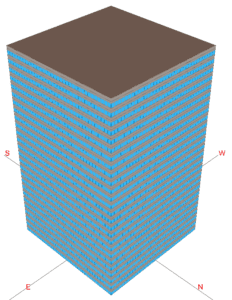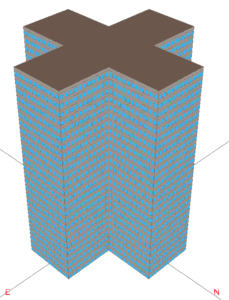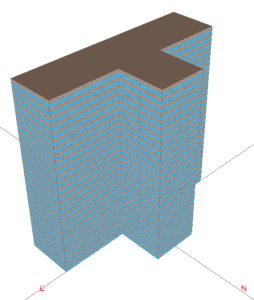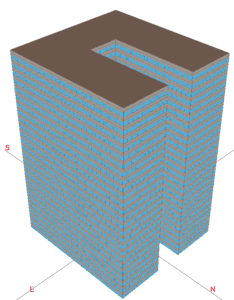
Square footage is square footage. Right? Well, not necessarily. When it comes to the type of building and how we discern energy savings, the shape of the building matters a great deal.
In the past, when an engineer attempted to ascertain a building’s energy consumption, they merely used the square footage numbers. But it turns out, it’s a bit more complicated than that. Varying shapes have a direct impact on how that building interacts with solar energy.
Essentially, a standard rectangle building interrelates with the sun’s rays far differently than an ‘X’ shaped building. A round-shaped building also interrelates differently for energy consumption than a ‘U’ shaped building. Running the numbers on the variances, even if each building has the exact same square footage, is revealing.
eQuest software
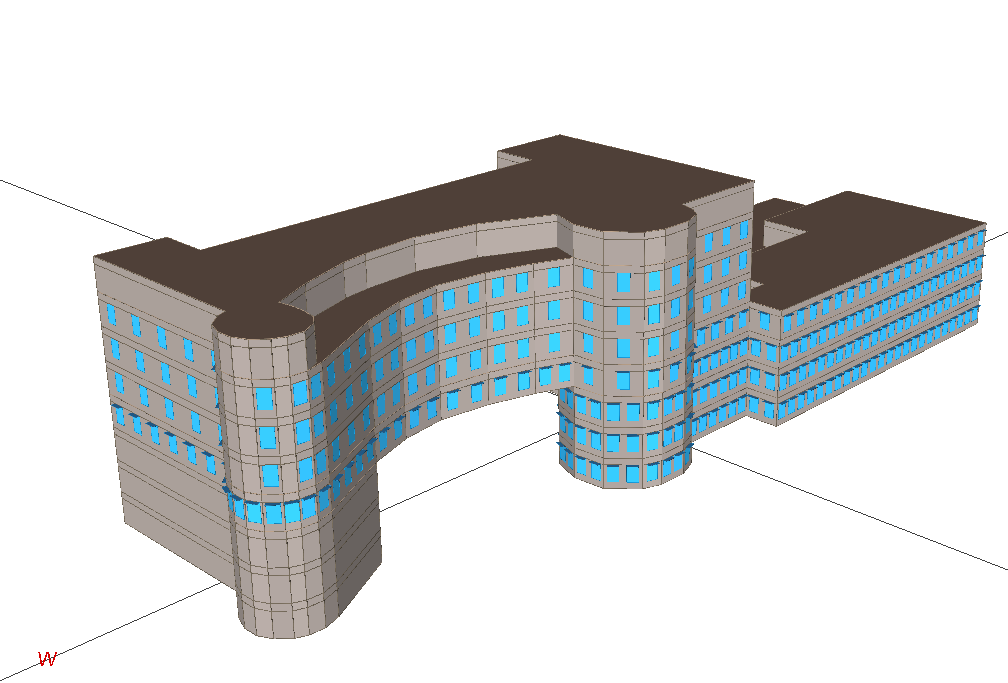
Hillcrest Heart Institute SW Elevation
As you may note from the software depiction above, the curves in this building will catch light, and with window film, reflect, absorb, or transmit that light, differently than other parts of the building. Both the architecture and orientation of the buildings will affect the hospital’s energy consumption. This medical campus has several buildings, all of which are different shapes and sizes.
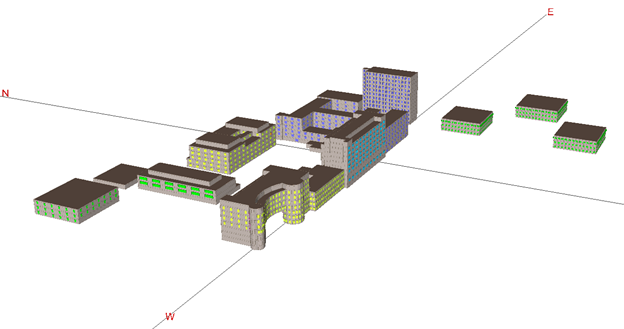
Hillcrest Campus
eQuest software can determine the energy usage and even savings, that window film will provide this campus – ahead of time. This software was initially enacted under the 2005 Energy Policy Act of 2005 (EPACT). It was extended in 2008 with the Emergency Economic Stabilization Act, and then again in 2015 under the PATH Act. This software is used to calculate commercial building tax deductions as well. eQuest is considered “qualified software” by the government specifically for this use.
For any building owner who desires to make their building as energy efficient as possible, utilizing the appropriate software is mandatory. NGS has implemented eQuest since 2012. Doing so affords our customer base premier insight into the true energy consumption and greenhouse gas (GHG) effects of their buildings. Consequently, it helps push us closer to carbon neutrality in commercial buildings – particularly large campuses.
Numbers don’t lie
Below is a table of the differences in energy consumption and electrical cost disparities for various shaped buildings. Keep in mind that all of these buildings have: 26 floors each 40,000 square feet, and are located in Los Angeles. They have identical glass makeups, HVAC systems, etc.
Annual electrical cost, as compared to a rectangular building, is represented in the right-hand column. These annual electrical costs are a result of the kilowatts used per hour (kWh) represented in the center column. The negative difference illustrates how much less that specifically shaped building, with the same square footage of the rectangle-shaped building, costs to heat and cool. In contrast, the positive dollar amount depicts how much more it costs to heat and cool compared to the standard rectangle-shaped building.
|
Building Shape |
kWh Difference | Annual Electrical Cost Difference[1] |
| Rectangle | Standard | Standard |
| Round | (-) 145,695 | $32,053 |
| X | (-) 10,062 | $2,214 |
| T | (-) 162,437 | $35,736 |
| U | (+) 83,010 | (-) $18,262 |
There is a vast difference between three of the five building shapes. The two that closely resemble other building outputs, still save thousands of dollars a year when compared to the closest counterpart or building. Numbers don’t lie. The shape of the building matters greatly when you are determining the base case energy consumption, and subsequent savings.
These figures would change if you applied solar window film to the exterior of these buildings. Moreover, the simulated building shape, elevation, and glass type must be right on the base case (building model) or the ECM projections are likely to be starting from an inaccurate base case. If you are considering the application of energy-efficient window film and are looking for accurate savings estimates, work with NGS. Our in-house engineering team understands how to do whole building energy modeling.
Shape the future of building energy efficiency with NGS
If you would like to receive a complimentary consult for your building regarding the energy savings from applying window film, contact our expert team. Our team uses the best eQuest technology to provide you with the most relevant information to become energy and GHG (Greenhouse Gas Emissions) efficient. We look forward to bringing you into the carbon-neutral future.
Photo Credit: Pixabay
[1] Assumes blended rate of $0.22/kWh


